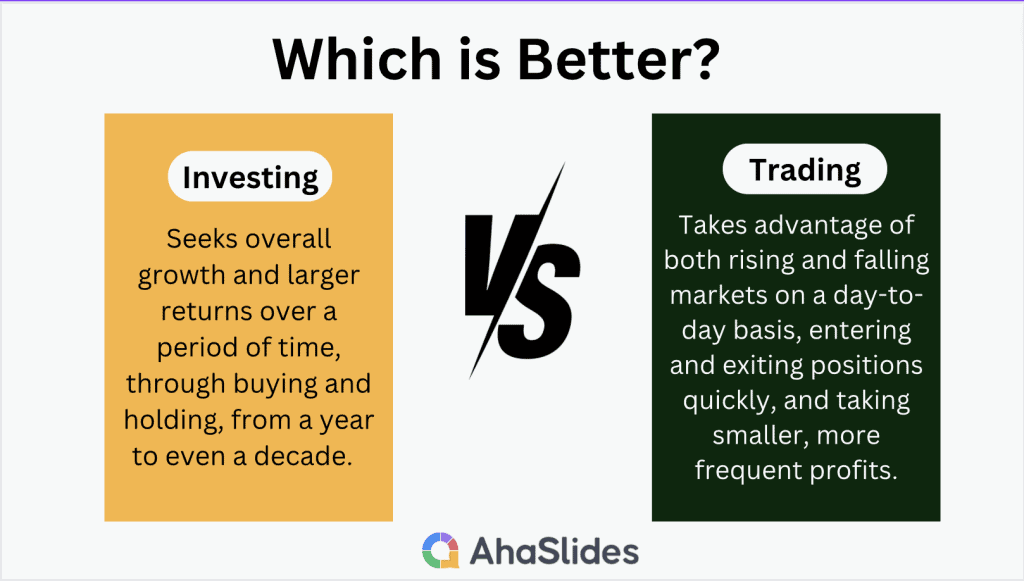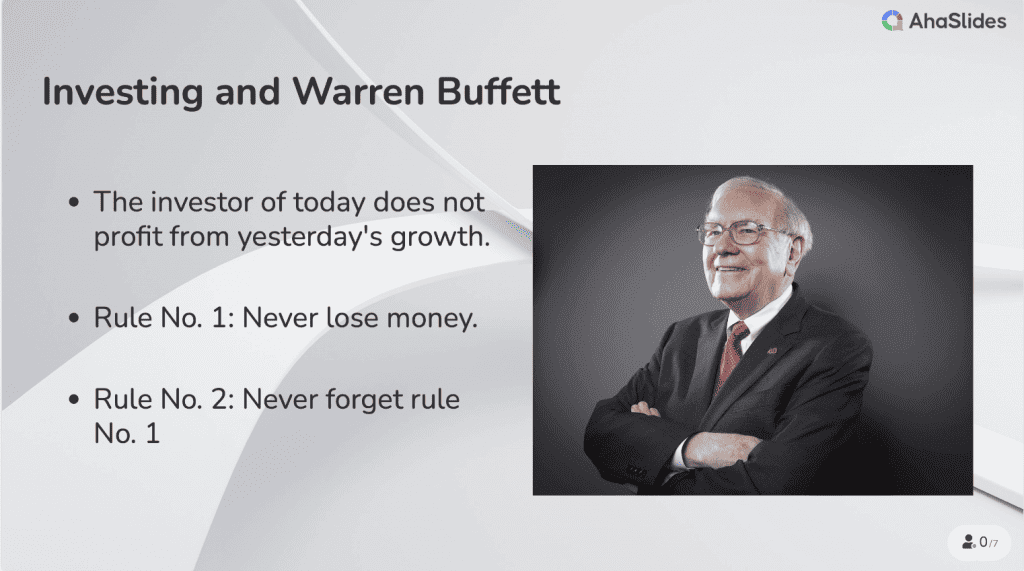Առևտուր, թե՞ ներդրում։ Ո՞րն է ավելի լավ։ Երբ ֆոնդային շուկայում շահույթ եք փնտրում, նախընտրում եք արժեթղթերի աճը և անկումը, որտեղ կարող եք գնել ցածր և վաճառել բարձր, թե՞ ցանկանում եք տեսնել ձեր բաժնետոմսերի բարդ եկամտաբերությունը ժամանակի ընթացքում։ Այս ընտրությունը կարևոր է, քանի որ այն սահմանում է ձեր ներդրման ոճը՝ անկախ նրանից, թե դուք հետևում եք երկարաժամկետ, թե կարճաժամկետ շահույթին։
Բովանդակություն:
- Առևտուր ընդդեմ ներդրումների: Ո՞րն է տարբերությունը:
- Ինչ է առևտուրը:
- Ի՞նչ է ներդրումը։
- Առևտուր ընդդեմ ներդրումների։ Ո՞րն է ավելի լավը։
- Վերջնական Մտքեր
- Հաճախակի տրվող հարցեր

Ներգրավեք ձեր ուսանողներին
Սկսեք բովանդակալից քննարկում, ստացեք օգտակար կարծիք և կրթեք ձեր ուսանողներին: Գրանցվեք՝ անվճար AhaSlides ձևանմուշ վերցնելու համար
🚀 Ձեռք բերեք անվճար վիկտորինան ☁️
Առևտուր ընդդեմ ներդրումների: Ո՞րն է տարբերությունը:
Ե՛վ առևտուրը, և՛ ներդրումը կարևոր տերմիններ են ֆոնդային շուկայում։ Դրանք ցույց են տալիս ներդրումների ոճը, որոնք ուղղված են տարբեր նպատակների, պարզ ասած՝ կարճաժամկետ շահույթի և երկարաժամկետ շահույթի։

Ինչ է առևտուրը:
Առևտուրը ֆինանսական ակտիվների, ինչպիսիք են առանձին բաժնետոմսերը, ETF-ները (բազմաթիվ բաժնետոմսերի և այլ ակտիվների զամբյուղ), պարտատոմսերը, ապրանքները և այլն, գնման և վաճառքի գործունեություն է՝ կարճաժամկետ շահույթ ստանալու նպատակով: Առևտրականների համար կարևոր է, թե որ ուղղությամբ կշարժվի բաժնետոմսը հաջորդը և ինչպես կարող է առևտրականը շահույթ ստանալ այդ տեղաշարժից:
Ի՞նչ է ներդրումը։
Ընդհակառակը, ֆոնդային շուկայում ներդրումներ կատարելը նպատակ ունի երկարաժամկետ շահույթ ստանալ և տարիներ մինչև տասնամյակներ շարունակ գնել ու պահել ակտիվներ, ինչպիսիք են բաժնետոմսերը, դիվիդենտները, պարտատոմսերը և այլ արժեթղթերը: Ներդրողների համար կարևորը ժամանակի ընթացքում աճող միտումն է և ֆոնդային շուկայի եկամտաբերությունը, որը հանգեցնում է էքսպոնենցիալ բարդացման:
Առևտուր ընդդեմ ներդրումների։ Ո՞րն է ավելի լավը։
Երբ խոսքը գնում է ֆոնդային բորսայի ներդրումների մասին, շահույթի շարժից բացի, կան ավելի շատ գործոններ, որոնք պետք է հաշվի առնել։
Առևտուր՝ ավելի բարձր ռիսկ, ավելի բարձր պարգևատրում
Առևտուրը հաճախ ներառում է ավելի բարձր մակարդակի ռիսկ, քանի որ առևտրականները ենթարկվում են շուկայի կարճաժամկետ անկայունությանը: Ռիսկերի կառավարումը կարևոր է, և առևտրականները կարող են օգտագործել լծակ՝ եկամտաբերությունը մեծացնելու համար (ինչը նույնպես մեծացնում է ռիսկը): «Փուչիկների շուկան» հաճախ է պատահում ֆոնդային առևտրում: Չնայած «փուչիկները» կարող են հանգեցնել որոշ ներդրողների համար զգալի շահույթի, դրանք նաև զգալի ռիսկեր են առաջացնում, և երբ դրանք պայթում են, գները կարող են կտրուկ անկում ապրել՝ հանգեցնելով զգալի կորուստների:
Լավ օրինակ է Ջոն Փոլսոնը. նա ամերիկացի հեջ ֆոնդի կառավարիչ է, որը կարողություն է կուտակել՝ 2007 թվականին ԱՄՆ բնակարանային շուկայի դեմ խաղադրույքներ կատարելով: Նա իր ֆոնդի համար վաստակել է 15 միլիարդ դոլար և իր համար՝ 4 միլիարդ դոլար, ինչը հայտնի է որպես պատմության ամենամեծ գործարք: Այնուամենայնիվ, նա նաև մեծ կորուստներ է կրել հետագա տարիներին, հատկապես ոսկու և զարգացող շուկաների ներդրումների մեջ:
Ներդրումներ՝ Ուորեն Բաֆեթի պատմությունը
Երկարաժամկետ ներդրումները, ընդհանուր առմամբ, համարվում են ավելի քիչ ռիսկային, քան առևտուրը: Չնայած ներդրումների արժեքը կարող է տատանվել կարճաժամկետ հեռանկարում, ֆոնդային շուկայի պատմական միտումը երկար ժամանակահատվածում եղել է աճող, ինչը որոշակի կայունություն է ապահովել: Այն հաճախ դիտվում է որպես ֆիքսված եկամտի ներդրում, ինչպիսին է դիվիդենտային եկամուտը, որը ձգտում է ստեղծել կայուն եկամտի հոսք իրենց պորտֆելներից:
Եկեք նայենք Բաֆեթի ներդրումային պատմությունըՆա սկսել է դեռ մանկուց՝ տարված թվերով և բիզնեսով։ Նա իր առաջին բաժնետոմսը գնել է 11 տարեկանում, իսկ անշարժ գույքի ոլորտում՝ 14 տարեկանում։ Բաֆեթի ներդրումային ոճը նրան բերել է «Օմահայի օրակուլ» մականունը, քանի որ նա մշտապես գերազանցել է շուկան և հարստացրել իրեն ու իր բաժնետերերին։ Նա նաև ոգեշնչել է շատ այլ ներդրողների և ձեռնարկատերերի հետևել իր օրինակին և սովորել իր իմաստությունից։
Նա նաև անտեսում է կարճաժամկետ տատանումները և կենտրոնանում է բիզնեսի ներքին արժեքի վրա: Նա մի անգամ ասել է. «Գինը այն է, ինչ դուք վճարում եք: Արժեքը այն է, ինչ դուք ստանում եք»: Նա կիսվել է իր մտքերով և խորհուրդներով բաժնետերերին ուղղված իր տարեկան նամակների, հարցազրույցների, ելույթների և գրքերի միջոցով: Նրա հայտնի մեջբերումներից մի քանիսն են.
- «Կանոն թիվ 1. Երբեք մի կորցրեք փողը։ Կանոն թիվ 2. Երբեք մի մոռացեք կանոն թիվ 1-ի մասին»։
- «Շատ ավելի լավ է գնել հրաշալի ընկերություն արդար գնով, քան արդար ընկերություն հրաշալի գնով»։
- «Վախեցե՛ք, երբ ուրիշները ագահ են, և ագահ եղե՛ք, երբ ուրիշները վախկոտ են»։
- «Ներդրողի համար ամենակարևոր որակը բնավորությունն է, այլ ոչ թե ինտելեկտը»։
- «Այսօր ինչ-որ մեկը ստվերում է նստած, քանի որ ինչ-որ մեկը վաղուց ծառ էր տնկել»:

Առևտուր ընդդեմ ներդրումների։ Ո՞րն է ավելի լավ շահույթ ստանալու համար
Առևտուրն ընդդեմ ներդրումների։ Ո՞րն է ավելի լավ։ Արդյո՞ք առևտուրն ավելի դժվար է, քան ներդրումը։ Շահույթի հետապնդումը և՛ առևտրականների, և՛ ներդրողների նպատակակետն է։ Եկեք դիտարկենք հետևյալ օրինակները, որոնք կօգնեն ձեզ ավելի լավ պատկերացում կազմել, թե ինչպես են գործում առևտուրն ու ներդրումները։
Առևտրի օրինակ՝ Apple Inc (AAPL) ընկերության բաժնետոմսերի օրական առևտուր
ԳնմանAAPL-ի 50 բաժնետոմս՝ մեկ բաժնետոմսի համար 150 դոլար գնով։
վաճառքիAAPL-ի 50 բաժնետոմս՝ մեկ բաժնետոմսի համար 155 դոլար գնով։
Վաստակել:
- Սկզբնական ներդրում՝ $150 x 50 = $7,500:
- Վաճառքից ստացված եկամուտ՝ $155 x 50 = $7,750:
- Շահույթ՝ $7,750 – $7,500 = $250 (առանց վճարների և հարկերի)
ROI=(Վաճառքի եկամուտ−Սկզբնական ներդրում/Սկզբնական ներդրում) = (7,750−7,500/7,500)×100%=3.33%. Կրկին, օրական առևտրում բարձր շահույթ ստանալու միակ միջոցը մեծ քանակությամբ բաժնետոմսեր գնելն է ամենացածր գնով և ամբողջը վաճառելը ամենաբարձր գնով: Ավելի բարձր ռիսկ, ավելի բարձր շահույթ:
Ներդրման օրինակ՝ ներդրում Microsoft Corporation-ում (MSFT)
Գնումներ. MSFT-ի 20 բաժնետոմս՝ 200 դոլար մեկ բաժնետոմսի համար։
Պահման ժամկետը՝ 5 տարի:
Վաճառք: MSFT-ի 20 բաժնետոմս՝ 300 դոլար մեկ բաժնետոմսի համար։
Վաստակել:
- Սկզբնական ներդրում՝ $200 x 20 = $4,000:
- Վաճառքից ստացված եկամուտ՝ $300 x 20 = $6,000:
- Շահույթ՝ $6,000 – $4,000 = $2,000։
ROI=(6,000−4,000/4000)×100%=50%
Տարեկան եկամտաբերություն=(Ընդհանուր եկամտաբերություն/Տարիների քանակ)×100%= (2500/5)×100%=400%։ Սա նշանակում է, որ եթե դուք ունեք փոքր գումար, ներդրում կատարելն ավելի լավ ընտրություն է։
Հնարավորություններ բարդացված և դիվիդենտային եկամուտների համար
Առևտուր, թե՞ ներդրում։ Ո՞րն է ավելի լավ բարդ տոկոսադրույքը։ Եթե նախընտրում եք ընդհանուր աճ և բարդ տոկոսագումար, ապա բաժնետոմսերում և դիվիդենտներում ներդրումներ կատարելն ավելի լավ ընտրություն է։ Դիվիդենտների վճարումները սովորաբար կատարվում են եռամսյակը մեկ և կազմում են բաժնետոմսերի արժեքի 0.5%-ից մինչև 3%-ը տարվա ընթացքում։
Օրինակ, ենթադրենք, որ դուք ցանկանում եք ամսական 100 դոլար ներդնել մի բաժնետոմսի մեջ, որը եռամսյակային դիվիդենտ է վճարում մեկ բաժնետոմսի համար 0.25 դոլար, ունի բաժնետոմսի ներկայիս գինը 50 դոլար և տարեկան 5% դիվիդենտների աճի տեմպ։ 1 տարի անց ընդհանուր շահույթը կկազմի մոտավորապես 1,230.93 դոլար, իսկ 5 տարի անց ընդհանուր շահույթը կկազմի մոտավորապես 3,514.61 դոլար (ենթադրելով տարեկան 10% եկամտաբերություն)։
Վերջնական Մտքեր
Առևտուր, թե՞ ներդրում։ Ո՞րն է ավելի լավ։ Ինչ էլ որ ընտրեք, զգույշ եղեք ֆինանսական ռիսկերից և այն բիզնեսի արժեքներից, որի մեջ ներդրում եք կատարում։ Սովորեք հայտնի առևտրականներից և ներդրողներից, նախքան ձեր գումարը բաժնետոմսերի մեջ ներդնելը։
💡 Ձեր գումարը իմաստուն կերպով ներդնելու ևս մեկ եղանակ։ AhaSlides- ը 2023 թվականի լավագույն շնորհանդեսների գործիքներից մեկն է և շարունակում է մնալ առաջատար ծրագրակազմ անհատների և բիզնեսների համար՝ ավելի գրավիչ դասընթացներ և դասարաններ ստեղծելու համար։ Գրանցվեք հիմա:
Հաճախակի տրվող հարցեր
Ի՞նչն է ավելի լավ՝ ներդրում կամ առևտուր։
Առևտուր, թե՞ ներդրում։ Ո՞րն է ավելի լավ։ Առևտուրը կարճաժամկետ է և ներառում է ավելի բարձր ռիսկ, քան երկարաժամկետ ներդրումները։ Երկու տեսակներն էլ շահույթ են ստանում, բայց առևտրականները հաճախ ավելի մեծ շահույթ են ստանում ներդրողների համեմատ, երբ նրանք կայացնում են ճիշտ որոշումներ, և շուկան համապատասխանաբար գործում է։
Ո՞րն է լավագույն տարբերակը՝ առևտուրը, թե՞ ներդրումը։
Առևտուր, թե՞ ներդրում։ Ո՞րն է ավելի լավ։ Եթե դուք սովորաբար ձգտում եք ընդհանուր աճ՝ ավելի մեծ եկամտաբերությամբ երկար ժամանակահատվածում՝ գնելու և պահելու միջոցով, ապա պետք է ներդրումներ կատարեք։ Ի տարբերություն դրա, առևտուրն օգտագործում է ինչպես աճող, այնպես էլ անկումային շուկաները՝ ամեն օր օգտվելով դիրքերից՝ արագ մուտք գործելով և դուրս գալով դիրքերից, և ստանալով ավելի փոքր, ավելի հաճախակի շահույթ։
Ինչո՞ւ են առևտրականների մեծ մասը գումար կորցնում։
Առևտրականների կողմից գումար կորցնելու հիմնական պատճառներից մեկն այն է, որ նրանք լավ չեն կառավարում ռիսկերը: Բաժնետոմսերով առևտուր անելիս ձեր ներդրումը պաշտպանելու համար շատ կարևոր է օգտագործել այնպիսի գործիքներ, ինչպիսիք են stop-loss պատվերները, և համոզվել, որ ձեր գործարքների չափը համապատասխանում է ձեր ռիսկի նկատմամբ հանդուրժողականությանը: Եթե դուք ճիշտ չեք կառավարում ռիսկը, ընդամենը մեկ անհաջող գործարքը կարող է խլել ձեր եկամտի զգալի մասը:
Ref: հավատարմություն | Investopedia







